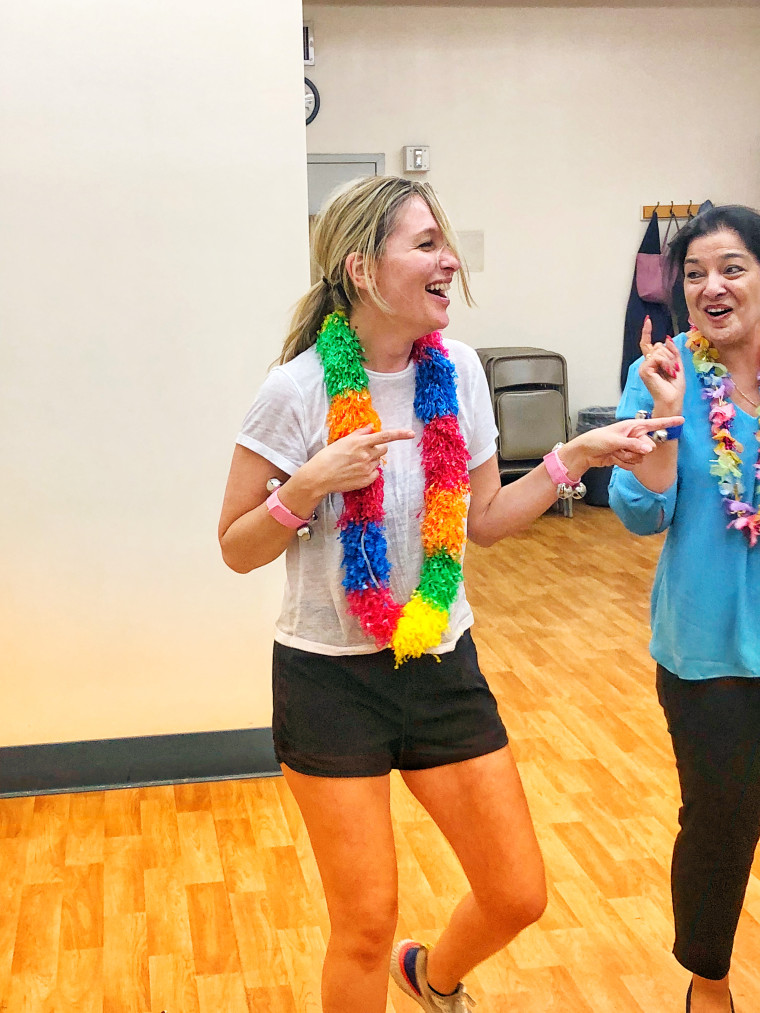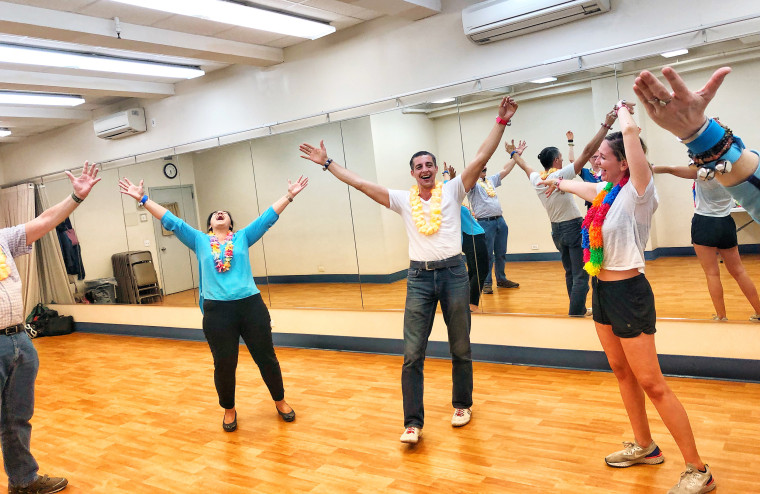When was the last time you laughed? I mean really laughed: a solid, hearty, belly-jiggling laugh. Chances are, many of us have a hard time remembering. That’s because as adults, we have a lot of things on our to-do lists (see: taxes, laundry, meal-prep, work meetings) and laughing is not a common occurrence during most of them.
It took me a few minutes to remember the time I laughed, which was two days ago when I saw a dancing dog in the subway. A few days ago isn’t too bad, right? One small study found that the average adult laughs 18 times a day. If there are so many opportunities for laughter each day — why was I missing pretty much all of them? I began to wonder when I had made the shift from finding the opportunity for lighthearted fun to focusing solely on the stressful parts of my routine.
In the book, “Anatomy of an Illness as Perceived by the Patient,” Norman Cousins famously explains how his self-prescribed “laughing cure”, which entailed 10 minutes of deep belly laughs, helped him sleep pain-free and reduce inflammation associated with his arthritis. And it seems he was on to something: Research shows that the act of laughing (and even simply the anticipation of a laugh) reduces stress hormones and improves blood flow to the heart, resulting in a more relaxed and improved mood.
"Spontaneous laughter, or laughing in response to something funny, is a critical part of the emotional spectrum and human experience,” says Meg Josephson, a licensed clinical social worker. “A review of the literature on the benefits of laughing conducted in 2016 noted that laughter has a reverse of the stress response, with decreased serum cortisol levels, and a decrease in epinephrine. It has even been shown to mitigate the effects that stress often has on the body. It has been shown to impact serotonin and dopamine activity in the brain and is suggested as an advantageous add on to any therapy, given that it is easy to use and noninvasive.”
In an effort to bring more laughter in my life, I decided to go in search of some activities that could help. While I could have gone the traditional route — set up a time to chat with my funniest friend or buy tickets to a comedy show — something outside the box caught my attention: laughing yoga.
What is laughing yoga?
I signed up for a class in New York City held at The Laughing Salon. For a decade, the teacher, a woman named Francine Shore, has been using laughter coaching and counseling techniques to help people going through life stage transitions by allowing them to unleash their joyful spirit and sense of play.
When I arrived at the class on a Tuesday evening, I had no idea what to expect. Would there be yoga mats? Would we chant? Would we giggle while trying to contort our bodies into various poses?
I quickly learned there would be none of that. Instead of yoga mats and towels, the props needed for class were colorful Hawaiian leis, bracelets with bells on them, and bright green pom poms. Instead of chanting namaste, we learned the chant “ho ho, ha ha ha”. It seemed yoga was a term used loosely — there would be no twisting our bodies into pigeon pose or Warrior 1. Instead, we’d be using them to float around the room, skipping and dancing.
“The unique idea of laughter yoga clubs was discovered by Dr. Madan Kataria, a physician from Mumbai,” Shore said. “Anyone can laugh for 15-20 minutes without depending upon great sense of humor, jokes or comedy. It combines laughter exercises (simulated laughter) and yoga breathing, which turns into real laughter when practiced in a group.”

The challenge: Leave your ego at the door
She instructed us to leave our ego at the door — which I nervously said goodbye to as I strapped the bells around my wrists — and just have fun.
The class started with Shore playing the song “Venus” by Bananarama, as all of us moved around and danced in a circle, making eye contact (which Shore said helps deepen our connection and the laughter). We then launched into a series of improv-like games where we laughed as if we were “driving a bumpy school bus” or “walking on hot sand". During each improv game, we laughed as hard as we could, maintained eye contact, and moved around the room. There was no correct way to approach the games in the class except to completely let go of any self-consciousness about how we looked — reverting back to a childlike mentality, exercising our imaginations and leaning into having some good old fashioned fun, for no reason at all.
I knew that in order to make it through the hour-long class and get the most out of the experience, I needed to have an open and non-judgmental attitude toward myself and the other participants. Which is easier said than done walking in from an outside world where we are constantly judged and forced to prove ourselves.
While it was certainly uncomfortable, I decided my approach would be to jump in with both feet. The first time Shore prompted us to laugh and be silly, I laughed extra loud and scooted around the room at full speed. This helped me forget quickly how far I was stepping outside of my comfort zone and before I knew it, the forced chuckles gave way to deeper belly laughs. The vibration of movement deep within my stomach made my entire body feel connected to the exercise, and my mouth began to ache from the constant smiling — which was more than I had done in the last few weeks combined.
After 45 minutes of laughing and sweat-inducing movement (with occasional stretching that gave my arms and limbs a chance to relax), we sat down for an 8-minute meditation. No laughing was involved; just the soothing sound of Shore’s voice as she guided us through a calming meditation complete with essential oils.
Laughter as a form of meditation
Throughout class, some of my laughter was real; other times it was forced. What I realized was that it did not matter.
Shore explained how our brains can’t process why we’re laughing (or smiling), whether it’s because we heard a funny joke or because we are forcing ourselves to do it. Plus, I saw firsthand how quickly a fake chuckle can spiral into an uncontrollable belly laugh. Shore has worked with individuals going through all kinds of tough situations — from diseases (like cancer or Parkinson's) to extreme stress (whether because of their career or a major loss) — and has seen the positive results that can come from letting go and laughing it up.
“I work with a lot of people who have losses and are living with cancer or who have had cancer,” says Shore. “Laughter yoga helps to ease their anxiety and helps with depression. The stress reduction [is an] effective tool, providing support, hope and coping skills, simply by allowing you to stay in the present moment (which I like to refer to as ‘The Now Zone’) [through] movement, intermittent breathing and meditation.”
Laughter yoga helps to ease anxiety and helps with depression ... simply by allowing you to stay in the present moment.
Shore says that she has also seen laughter yoga serve as a natural pain analgesic. “These exercises are value based, playful and Yogic but they are all ultimately about letting go and are very diaphragmatic. It helps to bring oxygen to the brain and all the cells in our body and helps to release all the feel good chemicals and endorphins.”
Josephson agrees that laughing can be therapeutic: "People have used laughter as a way to deepen their meditative state. One form of therapy done on patients utilizes laughter-driven meditation in conjunction with other types of therapy. In my experience, this is a technique that can be successful since it helps people laugh their problems away and frees them to examine their problem from a different angle," she says. "Anecdotally, people describe it as a way to unburden themselves in a way that is deeply relaxing and facilitates acceptance of their present situation."
The takeaway: My inner child needs to come out and play
At the end of class, we were asked to reflect on the difference between how we felt walking in and how we felt now as we were about to exit. Taking the deepest breath I have been able to take in a while, I recounted feeling the heavy weight of stress and nerves on my shoulders as I walked into class, fearful of what to expect. During the hour-long class I had felt more relaxed, but more importantly, I felt like, for the first time in a long time, I could be myself. My true funny, fearless, spur of the moment, silly self that I often mask when in the business world, around friends I’m trying to impress, or even when I’m alone with myself, lost in anxiety-ridden thoughts.
I thought the experience was going to simply be about laughing; maybe getting some of those feel-good endorphins rushing though my body and possibly de-stressing after a long work day. And while these things did happen, I have to admit that the best part of it was laughing off the layers of the person I try so hard to be from 9-5 and reconnecting to my inner child. Realizing that that kid is still a part of who I am today, but seldom gets the chance, or the stage, to show off to the world, was really eye opening. (And helped explain why I had fallen into a state of frequent anxiety with little room for laughter or play). I think I’m going to pencil in some time in "The Now Zone" and put that kid in the spotlight a little more often.
More ways to boost your mental health
- I swapped social media for meditation — and it turned me into a monster
- How to worry better
- Stressed? Here's how to tap into a Zen feeling almost instantly
- How to take a mental health day
- Smiling can trick your brain into happiness — and boost your health
Want more tips like these? NBC News BETTER is obsessed with finding easier, healthier and smarter ways to live. Sign up for our newsletter and follow us on Facebook, Twitter and Instagram.


